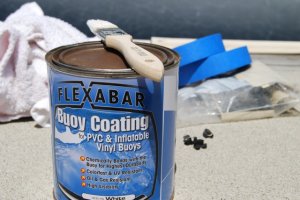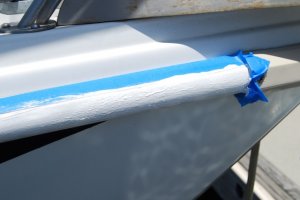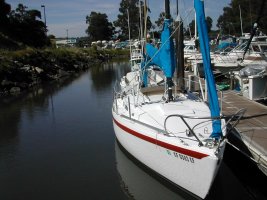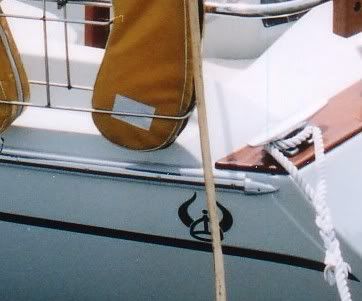Sven
Seglare
We did something wrong and will try to figure out what.
We got the buoy paint to chemically seal the rubrail and stop the chalking. This paint doesn't dry but actually chemically bonds with the rubber so it should be perfect.
We sanded the rail lightly and then rubbed it down with acetone, twice. It was a pretty thorough job. We taped off the top edge and went to work.
The Horror !
The paint was well mixed in the can and very smooth. However, once it touched the rubber it immediately lumped up and became impossible to lay on smoothly. You can see what it looked like in the picture.
Panic !
Fortunately it came off with acetone so the rubrail doesn't look any worse than before.
One of our slip neighbors suggested that maybe the paint reacted with the acetone. There was no residue left from the sanding so maybe he is right. Enough time had elapsed in the warm sun so that all of the acetone should have evaporated but I have no other explanation.
Unless someone here has some insights I'll try to ask the manufacturer for advice. The can did say to clean the brush with their thinner before applying but since it was a new china bristle brush I skipped that step.
The sanded/cleaned rubrail looks better than before but I'd like to know what is going on before we try again. The paint definitely sounds like the right answer if we can just get it applied right.
-Sven
We got the buoy paint to chemically seal the rubrail and stop the chalking. This paint doesn't dry but actually chemically bonds with the rubber so it should be perfect.
We sanded the rail lightly and then rubbed it down with acetone, twice. It was a pretty thorough job. We taped off the top edge and went to work.
The Horror !
The paint was well mixed in the can and very smooth. However, once it touched the rubber it immediately lumped up and became impossible to lay on smoothly. You can see what it looked like in the picture.
Panic !
Fortunately it came off with acetone so the rubrail doesn't look any worse than before.
One of our slip neighbors suggested that maybe the paint reacted with the acetone. There was no residue left from the sanding so maybe he is right. Enough time had elapsed in the warm sun so that all of the acetone should have evaporated but I have no other explanation.
Unless someone here has some insights I'll try to ask the manufacturer for advice. The can did say to clean the brush with their thinner before applying but since it was a new china bristle brush I skipped that step.
The sanded/cleaned rubrail looks better than before but I'd like to know what is going on before we try again. The paint definitely sounds like the right answer if we can just get it applied right.
-Sven




